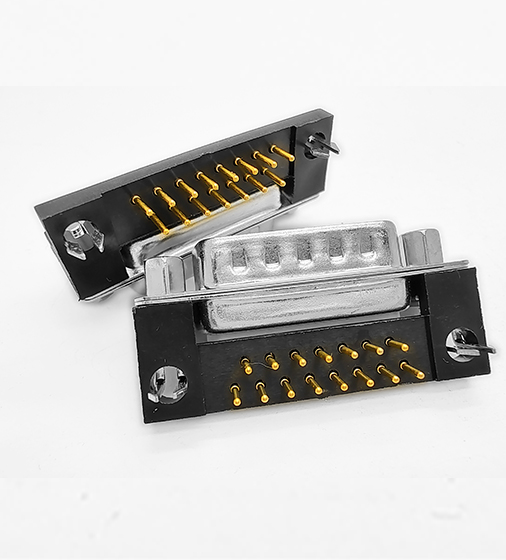Application of D-Sub Connectors in Computer Systems
2025-06-23
Application of D-Sub Connectors in Computer Systems
D-Sub connectors, or D-subminiature connectors, are a widely used type of electrical connector that has played a key role in the development of computer systems. Initially designed for use in communication equipment, D-Sub connectors have been adopted across various industries due to their durability, versatility, and ease of use. This essay will explore the application of D-Sub connectors in computer systems, highlighting their role in data transmission, display connections, peripheral interfaces, and more.
1. Data Transmission and Serial Communication
One of the primary applications of D-Sub connectors in computer systems is in serial communication. The RS-232 standard, which uses D-Sub connectors, has long been the go-to interface for serial data transmission. It was commonly used in early personal computers for modem connections, point-of-sale (POS) systems, and networking equipment. The D-Sub 9-pin and 25-pin connectors are particularly famous for their use in serial ports, allowing data to be transferred bit by bit across a single wire.
Even though USB technology has largely replaced serial communication in modern systems, D-Sub connectors are still found in certain legacy systems and industrial computers, where compatibility with older devices is necessary. For example, serial communication remains relevant in industrial automation systems, legacy data acquisition systems, and some specialized equipment.
2. Monitor and Display Connections
D-Sub connectors also have a significant presence in computer display connections. VGA (Video Graphics Array) connectors, which are based on the D-Sub 15-pin connector, were once the standard interface for connecting monitors to personal computers. VGA became the industry standard for analog video signals, offering a resolution range suitable for many early computer monitors.
While HDMI, DisplayPort, and DVI connectors have now become more prevalent for modern digital displays, VGA ports are still found on many legacy systems, projectors, and other specialized equipment. In these scenarios, the D-Sub 15-pin connector remains a reliable solution for video output, despite the shift toward higher-definition digital interfaces.
3. Peripheral Interfaces
In the realm of peripheral interfaces, D-Sub connectors have been used for connecting various input and output devices to computers. Parallel ports, for example, often use the D-Sub 25-pin connector for communication with printers and other peripherals. Although parallel ports have largely been replaced by USB connections, they were once widely used in desktop computers for high-speed data transfer to printers, scanners, and external storage devices.
Additionally, game controllers, mouse, and keyboard connections have historically relied on D-Sub connectors, particularly the PS/2 connectors, which use the 6-pin D-Sub configuration. Though PS/2 connectors have been replaced by USB ports in most modern systems, they continue to be used in some specialized systems or for retro-computing purposes.
4. Networking and Telecommunications
D-Sub connectors are also integral in some networking and telecommunications applications. For instance, Ethernet connections (specifically, early models of RS-485 or RS-422 networks) used D-Sub connectors, primarily the 9-pin or 25-pin variants. These connections are often found in industrial control systems, where they connect machines and devices in a local area network (LAN) or even across broader communication infrastructures.
In some telephone systems, D-Sub connectors have been used for connecting equipment such as PBX (Private Branch Exchange) systems or other voice/data transmission devices, where stable, reliable connections are crucial for maintaining signal integrity over long distances.

5. Prototyping and Test Equipment
In the field of electronics prototyping and test equipment, D-Sub connectors are often used in test and measurement systems. Their versatility in handling different pin configurations and robust locking mechanisms make them an excellent choice for specialized test equipment, where stable connections are necessary for accurate readings.
Engineers and designers in fields such as robotics, automated testing, and signal analysis often use D-Sub connectors to interface with oscilloscopes, signal generators, and other diagnostic equipment. Their durability and reliability ensure they maintain connection integrity during long-term testing and prototyping phases.
6. Other Industrial and Specialized Applications
Apart from the computer and telecommunications sectors, D-Sub connectors are also common in automated control systems, military and aerospace applications, and medical devices. In these fields, where ruggedness and reliability are paramount, D-Sub connectors serve as the interface for various control signals, sensors, and equipment.
For instance, in medical imaging systems, D-Sub connectors might be used to interface imaging devices with computers for data transfer or remote control. Similarly, in robotic systems, D-Sub connectors facilitate communication between various control modules, sensors, and actuators.
Conclusion
D-Sub connectors have maintained a significant presence in computer systems and various other industries, from their historical use in serial communication and monitor connections to their ongoing relevance in test equipment and legacy systems. While newer technologies and connectors may dominate the modern landscape, the versatility, simplicity, and reliability of D-Sub connectors ensure they continue to be widely used in certain contexts. As computer systems evolve, D-Sub connectors will likely remain a dependable option for interfacing with legacy equipment, specialized devices, and systems that require rugged, high-quality electrical connections.
As a professional manufacturer and supplier, we provide high-quality products. If you are interested in our products or have any questions, please feel free to contact us.